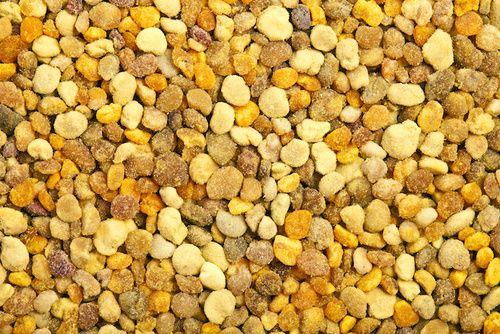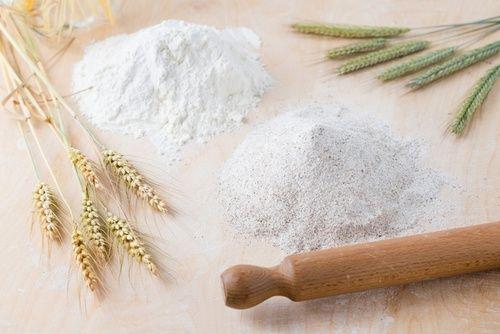- foods rich in vitamin B1, such as brewer's yeast or the pollen, are useful for nerve cells and the health of skin and hair. Let's find out better.
> Foods rich in vitamin B1
> Daily requirement
> A recipe rich in vitamin B1
Pollen rich in vitamin B1

Properties of vitamin B1
Vitamin B1 (thiamine) belongs to the category of water-soluble vitamins, which are conveyed through body water. Vitamin B1 is part of an enzyme (thiamine-pyrophosphate) essential for energy production, for the metabolism of carbohydrates, for the correct balance and for the function of nerve cells.
Like others of group B, thiamine is present in nature and the organism is able to synthesize it starting from the foods that contain it through the intestinal bacterial flora. If you often feel exhausted or tired often, if you have difficulty breathing or if you suffer from frequent muscle pain and have little appetite, you are probably in a state of vitamin B1 deficiency.
Main foods rich in vitamin B1
Vitamin B1 is an essential vitamin for the body found in certain food sources such as brewer's yeast, wheat germ oil, pollen and royal jelly, soy, whole grains, spirulina algae, dried fruit (hazelnuts, almonds, walnuts), molasses and sunflower seeds.
Absorption of vitamin B1 comes hampered by alcohol, smoking, too much coffee or you and the consumption of sweets and sugar. Even cooking and the simultaneous intake of seafood and raw fish (it is in fact destroyed by an enzyme present in raw clams, oysters and raw fish) negate the benefits of vitamin B1.
Hazelnuts
Hazelnuts contain 0,65 mg of B1 per 100 grams of product and, like other types of dried fruit (pistachios, walnuts and peanuts) are rich sources. The hazelnut also contains unsaturated fats, fibers, minerals (iron, copper, calcium and manganese) and other vitamins (E, B6, B9, B12) which make it a good fruit to reduce the presence of cholesterol in the blood and to help decrease cardiovascular risks. A good habit is to consume 3 a day, perhaps for breakfast, to give even more sprint to the day.
Brewer's yeast
Fresh brewer's yeast contains nearly 2mg of vitamin B1 per 100g of product. Good was therefore the advice of our grandmothers, when they said to dissolve half a cube at breakfast, especially in the development phase and in adolescence to strengthen the skin and hair. Brewer's yeast flakes also contain significant amounts of B1, which is suitable for supplementing vegan or vegetarian diets.
Wheat germ oil
Wheat germ oil contains almost 2,5mg of B1 per 100g of product. It is a very precious oil for health, which should always be kept in the pantry, to be used pure both to season salads raw and to soften and moisturize the skin or nourish the hair. Powerful antioxidant, it provides the body with proteins, good fats, mineral salts and, in addition to vitamin B1, also vitamin E, which counteracts the action of the feared free radicals.
Pollen and royal jelly
Both are particularly nutritious foods, in this product we find carbohydrates, proteins, vitamins (group B and folic acid) and essential amino acids, mineral salts (calcium, magnesium, potassium, zinc), lipids and unsaturated fatty acids. It is used dissolved in drinks, such as fruit juices, or consumed as it is, perhaps in yoghurt. All the B vitamins are found in pollen, in particular B1 and B3, with the exception of B4.
Alga spirulina
A food rich in valuable nutrients, spirulina algae is known and consumed as a food supplement. There are important photonutrients, vitamins (B1 and B12 above all), essential fats, mineral salts (calcium, magnesium, phosphorus, iron, sodium, potassium, manganese, zinc, selenium, among others), enzymes and proteins.
Also find out what natural vitamin B1 supplements are

Wheat flour among vitamin B1 food supplements
Daily requirement of vitamin B1
The average recommended dose for healthy adult men is about 1,5 mg, which becomes 0,9 for women. For adolescent boys it is 1,3 mg; from 51 years upwards it is 1,2 mg, as well as for women; pregnant and breastfeeding women should take an additional 0,4 mg. Children from 1 to 3 years have a requirement of 0,7 mg, from 4 to 6 years of 0,9 mg, and from 7 to 10 years of 1,0 mg.
Newborns up to six months have a requirement of 0,3 mg and from 6 months to a year of 0,4 mg. Alcoholics should take 10 to 100 mg of thiamine per day. The need for additional vitamin B1 increases in severe diarrhea, fever, stress, old age and surgery.
Recipe rich in vitamin B1
Risotto with hazelnuts
Ingredients for two people: 4/6 handfuls of rice (even better if wholemeal, richer in vitamin B1), vegetable broth, a leek or a spring onion, about 100 grams of hazelnuts, white wine, extra virgin olive oil, pepper, a little butter and grated Parmesan to whisk.
Preparation: fry the rice in a couple of tablespoons of oil, the toasted hazelnuts, skinned and coarsely chopped and the leek or spring onion thinly sliced, blend it with half a glass of white wine and cook over medium heat adding the boiling broth. When there are a few minutes left to cook, add a knob of butter, grated Parmesan cheese and pepper. Decorate as desired with some hazelnuts and a drizzle of acacia apples.
READ MORE
Fresh peas among foods rich in vitamin B1
Other articles on vitamin B:
> When to use B vitamins
| Thebeeshop.net


























